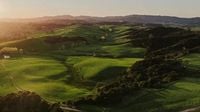New Zealand’s property market is making headlines once again, and this time, the story is about more than just numbers. As spring breathes new life into the housing sector, a surge in buyer demand and a rebound in prices are reshaping expectations nationwide. But it’s not just about the dollars and cents—innovative, environmentally conscious developments like Mangawhai Hills are setting a new standard for what Kiwi homebuyers might expect in the years ahead.
According to Trade Me’s Property Pulse Report, the national average asking price for a house in New Zealand climbed to $835,350 in September 2025, a 1.3% increase from the previous month. While prices are still 1.6% lower than a year ago, analysts say the momentum is unmistakable. Auckland, the country’s largest market, led the charge with its average asking price jumping to $1,024,850—a 3.7% rise month-on-month and the largest monthly gain since January. Though Auckland prices remain 1.8% lower than in September 2024, the city’s market appears to be waking from its slumber.
Gavin Lloyd, Trade Me Property’s customer director, captured the mood succinctly: “It’s a welcome sign of life for the Tāmaki Makaurau market. Not only are we seeing Auckland back in the million-dollar club, year-on-year demand is strong, up more than 12% on last year, and ahead of supply which is up 6%.” The data shows that properties in Auckland City, Manukau, and Rodney all increased by more than 6% month-on-month, while Franklin was the outlier, seeing a 5.9% dip.
But Auckland isn’t the only region making waves. The Deep South is outpacing much of the North Island, with Southland recording a 9.7% annual increase in average asking price to $539,150. The West Coast followed closely with an 8.9% rise to $493,350, and Otago saw a 4.1% bump to $879,550. Otago’s month-on-month growth was particularly striking, with the average asking price increasing by more than $84,000 and Wānaka alone seeing a leap of over $400,000—a staggering 21% jump compared to the previous year. Lloyd remarked, “Otago also showed particularly strong month-on-month growth from August, with the average asking price increasing more than $84,000. Wānaka alone saw an increase of more than $400,000 in the month, with year-on-year prices in the town up more than 21 per cent.”
Still, not every region is basking in the spring sunshine. Marlborough experienced the steepest annual decline at 9.3%, followed by Gisborne at 7.4% and Northland at 6.8%. These numbers highlight the patchwork nature of New Zealand’s housing market, where fortunes can shift rapidly from one region to the next.
Spring has also brought a burst of activity to the listings side of the equation. Trade Me recorded a 5.9% increase in new property listings year-on-year and a nearly 19% jump month-on-month in September 2025. Buyer search activity is also heating up, with a 24% increase compared to September 2024. Lloyd summed it up: “The spring selling season has kicked off with a burst of activity. More buyers actively looking and more properties coming to market suggests confidence is growing and we can expect a very busy spring for the property sector.”
For mortgage advisers, all this activity spells opportunity. With investor and upgrader confidence on the rise, falling interest rates following the recent Official Cash Rate (OCR) cut, and regional variations creating pockets of affordability, the coming months could be some of the most active in recent memory. Borrower inquiries are climbing, and advisers are well-positioned to help clients navigate the fast-moving landscape, especially in growth regions like the South Island.
While the numbers tell one story, the future of New Zealand’s housing market may be shaped just as much by the kinds of developments that are coming to market. Case in point: the Mangawhai Hills project, just north of Auckland, which is promising to be unlike anything else in the country. As reported by the Northern Advocate on October 10, 2025, the first 57 sections of this ambitious development are about to hit the market, with the eventual goal of building between 600 and 750 houses on a sprawling 185-hectare site.
What sets Mangawhai Hills apart isn’t just its scale, but its commitment to environmental sustainability and resilience. Every house will come equipped with solar panels, rainwater collection tanks, and primary wastewater treatment, all connected to a micro energy grid, stormwater detention ponds, and a wastewater treatment plant. About 500,000 native trees will be planted to offset the carbon footprint of construction, while 50 hectares of existing native bush and wetlands will be protected in perpetuity. The development will also feature 15 kilometers of walking and cycling tracks, open to the public—a nod to both international trends and the growing demand for active recreation.
Developer Patrick Fontein, who spoke candidly with reporter Denise Piper, is clear about his vision and his target market: Auckland empty nesters looking for a low-maintenance lifestyle. “My sales target is people who think they want a lifestyle block but find it becomes a lifestyle sentence because they spend all weekend doing maintenance around their block,” Fontein explained. “We’re providing the lifestyle for people but it’s low-maintenance lifestyle.”
The sections, ranging from 1000 to 1500 square meters, come with extensive eco-building and landscaping guidelines, including a single-storey restriction. Prices for the first stage range from $500,000 to $800,000, while house-and-land packages start at $1.3 million for a 200-square-meter home. Dogs are welcome, with each site fenced at the back and sides, but cats that aren’t contained may run afoul of the development’s extensive trapping in the bush.
Mangawhai Hills isn’t just about housing; it’s about community. A trust will be established to manage the native bush and wetlands, ensuring they remain public forever. A private high school, Mangawhai Hills College, has already been set up onsite, and each student will have a tree planted in their honor—a fitting symbol of the project’s environmental ethos.
Fontein’s approach is shaped by lessons learned during the Global Financial Crisis, when his earlier development, Kensington Park, nearly collapsed after banks called in their loans. This time, he’s relying on private investors, which he says allows for a more long-term, resilient outlook. “The environmental strategy needs a very long focus. Setting up our own power company and wastewater treatment plant takes quite a lot of capital to do, but I know that they’re right in the long-term.”
As New Zealand’s housing market enters a new phase—marked by rising demand, innovative developments, and a renewed sense of optimism—the coming months promise to be anything but dull. Whether buyers are looking for a city pad, a slice of southern paradise, or a sustainable haven like Mangawhai Hills, one thing is clear: the landscape is changing, and those ready to adapt may find themselves ahead of the curve.




